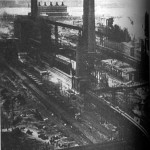 As we have now written on both industry and the condition of the workers it felt appropriate to conclude by comparing the two. Below therefore are your three attempts to draw two timelines on the same page (blue is industrial progress and pink is level of suffering for the workers), followed by your written justifications of your ideas.
As we have now written on both industry and the condition of the workers it felt appropriate to conclude by comparing the two. Below therefore are your three attempts to draw two timelines on the same page (blue is industrial progress and pink is level of suffering for the workers), followed by your written justifications of your ideas.
Remember the higher the position on the timeline the greater the industrial activity / level of suffering. The key here of course is to look at relative positions within and across timelines.
Task – Study your peers’ timeline and comments. Post a reply. What do you agree and disagree with ? Make sure to explain your thoughts using evidence (that you interact with ?).
Mr Kydd.
The Girls
Why we drew the industry line where we did
We started our line low for the reason that the Crimean war was the 1st instance showing how much Russian needed to industrialise. After the Emancipation edict, an internal market started to form, hence the reason our line rose. However, we didn’t rank overtly high, due to the fact that it would have only had a long-term effect and would have not been beneficiary for the short-term. We decided ‘The great Spurt’ was one of the first instances where Russia began to industrialise on an international level, leading to a heightening of line. However industrialisation rapidly decreased, plunging lowest in the 1918 treaty of Brest-Litovsk, where Russian lost 25% of its population; 25% of its industry and 80% of its coal industry. During Stalin’s second 5yr plan in 1935, the Russian industry grew to its highest point in the years of 1855-1964 – were the Russian economy was just equipped enough to defend themselves in war. Yet, in 1945 Russia’s industrialisation decreased due to the German invasion of Barbarossa . Ending our line with increase in Russia’s industrialisation due to the fact in the year of 1956 Russia was now publically classed as a super power, wining the space race. Examples of this is Russia’s launching of Sputnik in October 1953 – the first artificial earth satellite, and also the development of the Nuclear Bomb.
Why we drew the exploitation of the workers line where we did
Our view of the relationship between the two lines
The Boys
Why we drew the industry line where we did
From 1860-1890 there was a focus on industrialisation after the realisation of Russia’s backwardness in the Crimean war. The foundations of modernisation were being laid, culminating in Witte’s great spurt, with the highlight being the development of the Trans-Siberian railway which linked Russia’s population to its vast natural resources. However the First World War was further evidence for Russia’s lack of industrialisation, and the devastation of war communism along with the loss of large industrial areas under the treaty of Brest Litovsk led to levels of industrialisation dropping to pre- emancipation levels. Lenin’s NEP introduced a mixed economy that allowed for prosperity. As a result levels of industrialisation rapidly increased to pre-war levels. Russia reached its peak of industrial development under Stalin, as his unprecedented production output made Russia strong enough to defend herself from German invasion in the Great Patriotic War. Stalin transformed Russia from an agrarian country into a major industrial superpower. The Great Patriotic War had devastating effects on Russia including the loss of 36 million of her people. However the destruction was not as devastating industrially as that of the First World War due to the levels of industrialisation Stalin had achieved pre-war. When Khrushchev came to power in 1956 Russia was a major industrial superpower and was winning the space race. This was unquantifiable progress from the Russia that just 100 years previous had been humiliated in the Crimean War.
Why we drew the exploitation of the workers line where we did
With the lack of industrialisation pre 1855 most of the suffering occurred in agriculture and although there was exploitation of the serfs, everyone was at the same level. The graph starts so low because this early suffering was nothing in comparison to the suffering that occurred later. Under Vyshnegradskii’s policy of “export and go hungry” the amount of suffering increased, particularly in the 1891 famines. However post Witte, leading into war communism, there was a steady rise in suffering which runs parallel to the First World War. The reason for the sharp increase in suffering under War Communism, peaking in 1920-21 was due to the famines which led to the deaths of an estimated 15 million people. Under the NEP, private trade was once again allowed and peasants could once again sell their surplus crops for profit. This led to food production levels reaching pre-war levels once again. Acton calls this the “golden age” of the Russian peasant. From then on however we see the unique exploitation of the workers under Stalin. This is why the line increases rapidly until it reaches the greatest amount of suffering in the period in 1945. The Soviet Union had been devastated in the Great Patriotic War, 36 million citizens had dies and 70,000 kolkhozy had been completely wiped out. The amount of suffering then begins to decline under Khrushchev. Khrushchev did ease some of the suffering of the workers through his Virgin Lands policy and the focus of consumer goods which led to an increase in standards of living and a decline in suffering.
Our view of the relationship between the two lines
The main relationship between our two lines is that when industrialisation in Russia was increasing, so was the amount of suffering the workers experienced. This is shown by Witte’s Great Spurt in which Russia saw its first big industrial growth and made it the 5th largest industrial country in the world, but at the same time saw the suffering of the workers got worse and lead to the famine of 1891. As well as under Stalin’s five year plans when his unique amount of exploitation on the Russian workers lead to the biggest amount of industrialisation in the countries history, the amount of suffering for the workers reached its absolute peak , and with the of the Second World War as well, saw the death of 36 million Soviet Citizens. The only real exception to this is when the industrialisation of Russia collapsed during the First World War and because of War Communism, the level of the suffering actually increased, which lead to the famine of 1920-21.
The other relationship between the two lines under the NEP and Krushchev is that when they are industrialising that actually do more to make things better for the working classes. For example, the NEP brought food production back to pre war levels and allowed the peasants to sell their surplus once more. Under Krushchev he increases industrialisation, but not at the expense of the proletariats and the peasants, he introduces a focus on consumer goods and increases living standards, as well as implementing his Virgin Lands policy in the countryside.
Abul
(who decided to make his own stand)
Why I drew my Industry line where I did / why I drew my exploitation of the workers line where I did
(done together)
Wittie and pre-Wittie, although saw for example saw for instances rapid railways construction and increasing exports, the suffering during this period reached a peak under Vyshengradskii’s grain export drives, were is thought to have killed 3 million. In his own words “we must export and go hungry” and go hungry they did. Any obstacle face by the tsars was faced with brutal force for example Lena goldfield massacre thought to have killed 200
Although Lenin came to power and in theory severing was meant to decline via his Sovnarkom decrees, the need to win a war led to the economic policy of war communism. This was a greater peak than Vyshengradskiis as it affected both the peasants and the proletariat and killed a greater number of people.
However the NEP success after war communism should not be underestimated as it is considered as the ‘golden age’. For him first time peasants had surplus grain to sell on. ‘Surplus’ is a key word as it signifies that peasants had more than they needed which is very rare in Russian history. Bu 1925 food production had reached pre-war level.
After Lenin’s death Stalin stated that Russia was “50 to 100 years behind the advanced countries”. He exploited the proletariat to an extent where there was 8 million Zeks in the gulags and whole class of kulaks where wiped out in the process of de-kulakastion. The suffering reached a peak during war famine due to collectivisation where it is thought to have killed 36 million soviets.
After Stalin’s death Khrushchev de-nuances Stalin and quotes that “men feared there shadows” suggesting the unparallel levels of exploitation under Stalin. He put greater emphasise on consumer goods which incentives the peasants to increases productivity; furthermore his virgin lands policy greatly increased the amount of land under cultivation. This helped reduce exploitation.
My view of the relationship between the two lines
Industrialisation can be considered as proportional to exploration. Industrialisation was a strand of continuity and exploitation was a result of the need and want of rapid industrialisation. Under Reutern there was no real exploitation, the desire to industrialise was greater under Wittie and Vyshnegardskii who were intent on fulfilling great state projects e.g. trans-Siberian railway and drawing in foreign investment. The economic policies of Vyshnegradskii resulted famine which killed 3 million showing the proportional nature of exploitation and industrialisation.
Industrialisation was halted during war and greatly declined after it. Russia lost vast amounts of resources land, people and 80% of industry making both the peasants and proletariat suffer. War communism further increased the exploration.
NEP and Khrushchev are unique figures as they increased both industrialisation and standard of living. NEP made a profit motive while Khrushchev incentives people with greater number of consumer goods.
Stalin can also be considered as a unique figure as the levels of industrialisation and exploration was unparallel to any other Russian ruler. In the 1930’s growth rate averaged 12-13% but was hampered by war and Stalin’s policies along with war left 36 million dead and more than 8 million were enslaved in the gulags. The peaks therefore are greatest under Stalin.


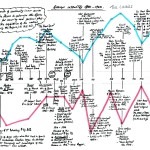

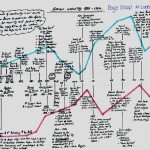
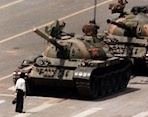
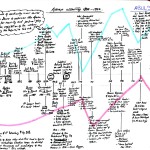


The Girls: One thing I disagree with in the girls table is the positioning of the line under during the Lena Gold m]Mine massacre. Yes undoubtedly the period under Vyshnegradskii and Witte the level of suffering for the workers reduced, but post Witte, leading up to the First World War, the suffering was getting gradually worse but not as bad as the Line drawn by the girls portrays, it is very high and is not far from being as high as the line under Stalin, where without doubt the suffering is at its worst. therefore the fact that by 1912 the Girls have the line so high I don’t think is right. The amount of strikes at this time (3754) shows that things weren’t as good but not as bad as the drawn by the girls would seem to suggest and the Lena Gold Mines massacre in which 200 people died indicates that suffering for the workers was still at a fairly bad but not as bad as the Girl’s say.
One thing I agree with is that the greatest amount of industrialisation came within the period of the Second Five Year Plan under Stalin. The positioning of their line is very similar to us boys. Heavy industry, making Russia a major industrial power able to compete in the Second War shows how great the industrial growth was in this period and the Girl’s line is correct to suggests this as the biggest amount of growth.
Abul: Similarly like the Girl’s line, it is very high during the lead up to the First World War, which doesn’t allow the chart to shows just how drastic the suffering became during the First World War and then later War Communism under Russia. Where as our line shows a gradual increase to highlight the intensity of the Suffering during 1914-1922.
Another thing I disagree with is the level of industrial growth post Stalin, yes it goes up under Khrushchev but no way as much as the Abul has shown on this chart. He has drawn the line as high a the high industrialisation period under Stalin which saw the biggest amount of industrialisation in Russia’s history, so under Khrushchev it would not have been so high. Yes Khrushchev introduces new technology like radios, cars etc. but these new consumer goods did not help Russia to industrialise to the level that Abul has said.
One thing I agree with is the greatest amount of suffering came under Stalin, when 36 million civilians died and 70,000 Kholkozy were destroyed due to the impact of industrialisation and the Second World War. The line Abul has drawn is pretty much the same as us boys, although we didn’t draw our line actually off the chart like Abul.
The Girls: I feel that the girl’s line for industrialisation rises too rapidly. Pre Witte industrialisation was very limited and in small pockets. I also think that the line is too high at the Great Spurt. Whilst Russia was clearly growing industrially, at this stage she is still far behind the leading powers and by no means able to defend herself. I agree with the girls that there is a large drop in the level of industrialisation in 1918 due to the devastation caused by the war. I would however argue that the drop in level in industrialisation in 1918 is not as big as it should be. I would argue that levels of industrialisation dropped back to pre-emancipation levels due to the vast destruction of Russia during the war. I then agree with the majority of the rest of the line. Industrialisation increases rapidly under Stalin then declines in the second world before rising once again under Khrushchev.
I feel that the girl’s line for level of suffering does not start low enough. Whilst the workers did suffer greatly under serfdom, it does not compare to the vast scale of suffering of the workers in later stages of the course. I also feel that the level of suffering did not rise and decline as rapidly as the girl’s line suggests. There certainly were times when life got better and worse for the workers but it was generally a very hard life.
Abul: I feel that Abul’s line for industrialisation starts too high. In 1855 there was virtually no industrialisation in Russia and it was certainly a very Agrarian society. I also feel that the line rises too high for the Great Spurt. Whilst Russia did certainly begin to industrialise at this time she was still far behind the leading economic powers. I agree with Abul that in 1918 there was a huge rapid drop in industrialisation to pre-emancipation levels due to the vast destruction of Russia during the war.
I agree with Abul that comparatively the suffering of the workers starts fairly low and then gradually rises as Russia starts to industrialise. I feel that the suffering under war communism should perhaps be slightly higher. There was huge suffering under war communism including the food shortages which led to the deaths of millions. I certainly agree with Abul that the greatest suffering of the workers happens under Stalin. This was a time of huge suffering where the workers lived in fear of the gulags.
GIRLS
There are several points with which I do not agree with, for the girls. Firstly I would argue that the emancipation edict actually increased suffering for the people as it only replaced on form of repression for another.
Secondly I don’t understand why they show suffering as declining in 1917 when Russia was at war, although Lenin came in and had sincere ideas he could not implement them due to harshness of the treaty of Brest-Litovsk and the break out of civil war. During this time peasants faced food rationing and grain requisitioning.
Thirdly I don’t see why they believe that suffering reduced under Stalin in 1935. Stalin was responsible for the killing of tens of millions of people and as Khrushchev states “men feared there own shadows”. Although some like the stakonvites did well they also feared for there lives as there own colleagues killed them out of hatred.
Finally if we look at there graph they place war communism and Second World War at relatively the same position for impact on workers. This is false. During the Second World War a greater number of people died and were suffering. Just considering the fact that 36 million people died is enough evidence to suggest that Second World War was the pinnacle of suffering for the peasants as I clearly show in my graph.
BOYS
The boys do not consider things in relative proportions. In there graph, war communism is above the famine of 1931. War communism and famine of 1921 is thought to have killed ~4-6 million. 1931 famine killed a similar number of people furthermore 8 million Russians were working themselves to death in the gulags. This point should be at least the same position if not higher.
Furthermore they do not show the extent of the suffering the Russians faced in the Second World War. 36 million dead is far greater number than 6 million due to war communism so, this position should be much higher. If I could have positioned my own point out of the graph I would have.
lastly, I don’t think they give Khrushchev the credit he deserves for industrialisation. When we consider great achievements like the first man in space was Russian, and the development of the atomic bomb furthermore new industry like rubber and chemical being established his position should be higher. Industry is not just “heavy industry” which Stalin focused on. Khrushchev carry’s on Stalin’s post war recovery further rejuvenating it with modern industry. some even argue that Russia was winning the cold war in the 50’s suggesting the great extent of it industry.
🙂
I feel that the girls have been overly generous with regards to Russia’s early industrial growth as although examples like the encouragement of foreign investment were ideas previously un-explored, by this time it was one of few feasible options left in order to stimulate growth. I also disagree with the progress dropping with grain exports, as this was a feasible way in which Russia could stabilise an income. However on further consideration I feel that our group should have placed Witte’s great spurt higher as it layed solid foundations that were built on by Lenin and Stalin, and his Trans-siberian railway was desperately needed in Russia and was successful, unlike Stalins great state projects. I then feel the progress line should drop deeper as the ladies have put the Treaty of Brest Litovsk and War Communism as more progressive than the Emancipation Edict that began the growth of an internal market. I agree with their level of progress under Stalin, however feel that they have greatly over-estimated Khrushchevs achievements as he came to power when Russia had already been strengthened to the point that any leader would of expected to progress into the world power, and he doesn’t deserve the recognition for largely continuing what was already in place.
I disagree that Russia’s early industrialisation had anywhere near the same sort of impact on the workers as some later Stalinist policies, and feel that early on exploitation was at it’s low point of the whole period. I then feel that the ladies go on to be far to absolute with their high and low points, and have failed to consider the impacts that the “good times” may have had. E.g The lesser suffering under Lenin and the birth of Kulaks caused them to suffer more than anyone under Stalin and therefore Lenin still had an impact by introducing dreaded Capitalism that produced almost a class of ‘better people’ that Stalin targeted.
Abul
Although I feel Abul’s progress starts at a point too high, i do agree with the upward curve to the “great spurt”. He then leaves this line at the same point despite the fact Russia had largely failed to build on Witte’s policies by the time they became involved in the first World War where his progress line rightfully drops rapidly. It then seems to plato slightly under Stalin’s first 5 year plan when a huge amount of progress was made so i feel this should have been exponential growth rather than his line levelling out. I again feel Abul has been overly generous with his assesment of progress under Krushchev when his policies effectively mimicked what had already been put in place.
And his impact on the workers is largely similar to ours.
Many thanks x
The girls: There are several points with which I do not agree with, for the girls. Firstly I would argue that they did not consider how the emancipation edict actually increased suffering for the people as it only replaced on form of repression for another (redemption payment). However I do agree with the acknowledgement that they made about the fact that the emancipation edict was a long term measure for industrialisation which if it wasn’t present , industrialisation would have been much slower.
Secondly I partially when they show suffering as declining in 1917 when Russia was at war because Lenin came in and some had good and sincere ideas however because of the harshness of the treaty of Brest-Litovsk he could not implement these ideas into active policies and the break out of civil which war which consequently led to war communism .
Finally I do agree that suffering reduced under Stalin in 1935. Although Stalin was responsible for repression to the extent that “men feared there own shadows” , life improved for women as their rights became
Acknowledged .It is also important to acknowledge that the stakonvites did well and became the image of industrialisation , attracting young communists. The fact that there was still an immense amount of support for stalin’s plans shows the extent
In which his ideas were acceptable to the population of Russia .
The boys : in their graph, war communism is above the famine of 1931. War communism and famine of 1921 are thought to have killed ~4-6 million people , I think that it is correct of them to place war communism above the famine because we could argue that the famine is a consequence of war communism which would suggest the brutality of its policies were on a large scale which the NEP could not even tackle without foreign aid.
However they do not show the extent of the suffering the Russians faced in the Second World War. 36 million dead is far greater number than the 6 million under communism and because of this i think that this should be a little higher . If I could have positioned my own point out of the graph I would have.
lastly, I don’t think they give Khrushchev theThere are several points with which I do not agree with, for the girls. Firstly I would argue that the emancipation edict actually increased suffering for the people as it only replaced on form of repression for another.
Secondly I don’t understand why they show suffering as declining in 1917 when Russia was at war, although Lenin came in and had sincere ideas he could not implement them due to harshness of the treaty of Brest-Litovsk and the break out of civil war. During this time peasants faced food rationing and grain requisitioning.
Thirdly I don’t see why they believe that suffering reduced under Stalin in 1935. Stalin was responsible for the killing of tens of millions of people and as Khrushchev states “men feared there own shadows”. Although some like the stakonvites did well they also feared for there lives as there own colleagues killed them out of hatred.
Finally if we look at there graph they place war communism and Second World War at relatively the same position for impact on workers. This is false. During the Second World War a greater number of people died and were suffering. Just considering the fact that 36 million people died is enough evidence to suggest that Second World War was the pinnacle of suffering for the peasants as I clearly show in my graph.
BOYS
The boys do not consider things in relative proportions. In there graph, war communism is above the famine of 1931. War communism and famine of 1921 is thought to have killed ~4-6 million. 1931 famine killed a similar number of people furthermore 8 million Russians were working themselves to death in the gulags. This point should be at least the same position if not higher.
Furthermore they do not show the extent of the suffering the Russians faced in the Second World War. 36 million dead is far greater number than 6 million due to war communism so, this position should be much higher.
Finally I think that they are correct give Khrushchev little credit for industrialisation . When we consider the fact that khruschev’s main projects were the space projects , yes , it seems like he did so much as these space projects did put russian in a position that they were winning the Cold War . However we could say that all he did was carry on stalin’s policies in a prolonged an less aggressive manner therefore undeserving of the credit of industrialisation , we know this to be true because he did not end things like collectivisation which were part of stalin’s policies . On the other hand I think it should have been a bit higher because we should consider that industry is not just “heavy industry” which Stalin focused on. Khrushchev focuses on the development of more consumer goods which consequently increases the standards of living for many Russians and they are true signs of modernisation.
we consider great achievements like the first man in space was Russian, and the development of the atomic bomb furthermore new industry like rubber and chemical being established his position should be higher. Industry is not just “heavy industry’ Stalin focused on. Khrushchev carry’s on Stalin’s post war recovery further rejuvenating it with modern industry.
The Boys: Overall, I agree with the trend line for the industrial activity, however there are a few that I disagree with. I think the position of the line should be lower when the NEP comes into effect. Yes, there was more industrial output than in 1917, but the NEP mainly focused on improving the lives of the peasants and agrarian reforms. Not much attention was focused towards heavy industry in my opinion. Also, I think the line should be higher after 1956. It is clear there was perhaps less industrialisation going on after Stalin’s death, but it must be taken into consideration that by this point Russia was arguably the most industrialised country and engaging in the Cold War with America.
When looking at the line for suffering, I think it should be slightly higher between 1861 and 1881 because of overcrowding and disease in the cities due to urbanisation. Many peasants migrated to towns to earn extra money for the redemption payments and from having less land to farm. As a result of this, many were living in cramped conditions which easily spread illnesses like cholera. Other than this I agree with the line
Abul: I think the line should be lower when it comes to “The Great Spurt” because, in comparison to Stalin’s rule and policies, industrial activity was much lower. Also industrial activity should be lower during 1914-1917 as much of its activity was focused on the war, so (in theory) heavy industry would have lowered greatly. I think that if heavy industry is defined as work in factories and railways, the line should be lower as, at the time, not mcuh progress was being made as attention was focused on the war.
Overall, I agree with the line of suffering, however suffering during 1945 is too high in my opinion. It is evident that this was the time of the most amount of suffering with 36 million dying due to war, invasion and hunger from collectivisation . Although I think it should be taken into consideration the population of Russia at the time. Compared to other times of suffering, like during War Communism, the suffering the population faced when relatively the same as it had grown significantly over time. So, in proportion, these two points should be level.
For the girls I believe their industrial progress line rises to quickly. The reason for this is because previous to the ‘Great Spurt’ there was very little industrialisation. The girls line also too rapidly and at a low peak in 1933 around the stakhanov movement, where i believe there was exploitation of the workers during this period due to the 5 year plan. However i do believe the girls can be given credit also. During the 1918 period there line drops just after war communism and then rises due to the welcoming of the NEP, however I do believe the lines could be dropped even more during war communism cause this was a period during war and war communism which had a huge impact on the workers.
For the boys i believe in there timeline do not show the extent of suffering the Second World War, which yet again was a huge factor during this period of time alongside war communism. However the rest of there timeline looks acceptable to me.
The boys:
Overall we agree with the majority of the industry line, however there is a couple of points that we would disagree with. The first being ‘The Great Spurt’. Personally we feel that this point should be a little higher as it gave them a sense of industrialisation as before Witte industrialisation was very limited. Under Witte value output of all industry doubled in ten years, railway construction was second only to the US and the value of imports rose from 651.4 million roubles in 1904 to 1106.4 million roubles. This is why we feel that this point should be higher on the boy’s graph. We also think that the point of the USSR being a super power should be significantly higher, as Russia went from being a country without industrialisation to a country with an industry and creating their own new ideas.
After looking at the suffering line we feel a couple of points could be higher such as the line between 1904 and 1914. This is due to the fact that a number of people died and these strikes led to Bloody Sunday and 1.4 million days being lost as strike levels increased in 1914.
Abul:
On Abul’s industrial graph there are a number of points that we disagree with. The first point on the graph we feel is placed to high as Russia was completely backwards when it came to industry. We also feel the point of Treaty Of Brest Litovsk is placed to high as Russia lost 25% of its industry and 80% of its coal industry which is a significant loss.
We agree with some of the points on Abul’s suffering line, however the main one we disagree with is where he has placed War Communism. Personally we feel that this should be placed a little higher as by end of 1921 the famine threatened over 36 million Russians and by 1922, millions were already dead.
Abul:
The industrialisation line for the Tsarist period is too high. In particular, the level of industrialisation during the Great Spurt was not really comparable to that which would later occur under Stalin, but the lines are at similar levels. Industrialisation between the end of the war and Stalin’s first Five Year Plan was not linear either – War Communism didn’t little for industrialisation and while things did improve under the NEP, arguably this mainly benefited agriculture and was in place for too short a time to have a large impact on industry. I disagree that the level of industrialisation fell after the first Five Year Plan. While subsequent plans were not necessarily as successful, industrialisation remained at a high rate until the Second World War.
The suffering line suggests a decrease in suffering after 1918, but the policy of War Communism was actually very repressive. Conditions improve under the NEP (for example, the creation of NEPmen), and suffering only starts to increase relative to War Communism from around 1928. At this point it remains increasing and high until the end of the war, and decreases as you say.
Girls:
Similarly, I think the industrialisation line is too high for the pre-1917 period. The drop in industrialisation after the end of the war does not recover until the late 1920s, hence the line is much too high and steep between 1918 a 1928. The relative increase in industrialisation between 1928 and 1941 should be the biggest on the entire graph, but here is shown to actually decrease.
Suffering was no where near as high at the start of the period as on the graph and should be much lower, for example, than Vyshnegradsky’s man-made famine. As mentioned above, suffering should not be shown to decrease immediately after 1918, and remained high until at least 1922, when it did drop until 1928. Suffering between 1928 and 1932 is shown to decrease, when actually this period is when it really began to increase, in particular due to the famine of the early 1930s. It then should remain consistently high until reaching a peak in 1945.
Boys:
The industrialisation line is more accurate up until the Great Spurt, but I don’t think the drop off after it should be as marked as it is. The real decline came during the war, not really before. Activity was low in the immediate aftermath, although perhaps not quite as bad as at the start of the period. Like with the girls, the industrialisation line increases too rapidly in the 1920s, it should not begin to shoot up until 1928. The post-war decline was not so bad as to take them back to 1928 levels, and I would argue the line should be steeper in the post-war era as industrialisation focused to more socially useful goods such as consumer goods.
The suffering line I think is the most accurate, as it shows that suffering did increase after the war under War Communism, and also that the big increase came in the 1930s, before decreasing after the war. The gradually increasing suffering throughout the Tsarist period, with a jump under Vyshnegrasky I think is accurate.
I think that overall the Boys graph is the best, as it shows suffering most accurately. Of the comments here, Luke D’s is the best as he makes the point that despite some progress under Tsarism, the Great Spurt should not be shown as that high on the graph as not that much progress was made, and similarly that the relative level of suffering in the Tsarist period was much less than it would later be under Stalin.
A couple of general points:
-suffering is shown to decrease immediately after 1945, but arguably this only started to happen from 1953 at the end of Stalinism
-The major period of industrialisation was from 1928 until the outbreak of war. All of the graphs show industrialisation almost reaching a peak before 1928, but Russia didn’t recover to pre-war levels until almost that late. The biggest jump should come between 1928 and 1941.
-Similarly, owing to the Great Terror of 1936-8, suffering should be shown to jump during the mid 1930s (not decrease as the girls said!), although this is not directly related to industrialisation, it was arguably the biggest cause of suffering in the entire period.